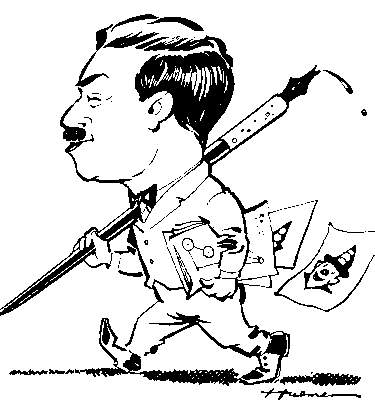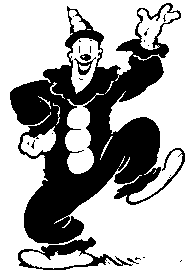|



              
 |
Working
for the Fleischers (continued)
An
Interview with Dick Huemer by
Joe Adamson
(page
2 of 3 pages)
Adamson:
McCay was a sober, timid
sort of
person, wasn't he?
Huemer:
Well, he wasn't sober this
night. Who
was? He got up and he said,
"Now I'm
going to put you fellows wise
to something
that I've just discovered.
Instead of
working straight ahead,
which makes it
hard to know where
you're going
in animation, why don't
you take
drawing No. 1, and then look
ahead and make
drawing No. 5; and
now look, you
can put drawings No. 2,
3, and 4 right
in between!" He was tell-
ing us about
the in-between system! Of
course, we
respected him so much that
nobody said,
"Aw, come off it, we've
been doing it
since 1915." So that's how
we know that
he must have animated
straight ahead.
Adamson:
So you were doing the in-
between system
from the time you
started?
Huemer:
Oh, sure. And we wouldn't
let anybody
touch our in-betweens. We
had no
in-betweeners. It was pretty im-
portant that
we did all this ourselves. It
was too
precious to let some jerk come
in who maybe
didn't know how to
draw, and
monkey with your stuff. As a
matter of
fact, for the record, in all
modesty, I'm
the first one to use in-be-
tweeners. And
it came about when I
was working
for the Fleischers. They --
poor fellows
-- liked my work so well
that they
said, "Why don't you do more
of it? 1 mean
by having someone do the
in-betweens?"
And my first impulse
was "Oh,
yeah? I will, like hell!" Then,
being
basically a very lazy fellow, I
thought,
"Why not?" So, Art Davis was
assigned to me.
Adamson:
Is in-betweening invaria-
bly tedious?
Huemer:
Well, it's not the least crea-
tive. You
don't dare be creative about
in-betweening.
The extremes create the
action, the
mood, or whatever you want
to put over
the point.
Adamson:
Were you satisfied with
Davis' work?
Huemer:
Oh, fine. Didn't know the
difference
when the scene was run! In-
betweening had
been born!! Ta-dee-
ahh!
Adamson:
What percentage of the
drawings did
he end up doing?
Huemer:
About 75. In those days, we
exposed our
own animation, right on
the paper. We
didn't even have ex-
posure sheets.
Made notations down in
the corner.
Suppose you had somebody
repeating an
action, you'd write, "R and
R" --
repeat and reverse -- "five times
stopping on
8," then you go ahead. Of
course when
sound came along, you had
to have
exposure sheets to give you the
exact
locations of sounds and notes, etc.
There
is an amusing incident that ex-
plains how
careful we were in drawing
our things
when we worked in pen and
ink with
Gillott pen points -- they had
to be
Gillott's 290s, the famous English
pen points,
the kind Charles Dana Gib-
son used. Some
guy was animating an
explosion and
he noodled up this draw-
ing of smoke
and things breaking, and
all hell
breaking loose, and he made
such a
beautiful drawing of one of these
gorgeous
in-betweens that he held it for
five
exposures, or six, a definite stop.
He couldn't
stand having the thing go
through in one
exposure, as it should
have, jesus!
His work of art might have
been missed! I
could tell you his name,
but he's a
friend of mine.
Our
inking techniques were very in-
teresting,
some guys were very good.
You'd put
shading on whatever didn't
move too much,
if you wanted to. In
preparation
for photographing, we did
the clown in
the rip and slash system,
which means
cutting the papers out to
fit over each
other -- like a puzzle. We
used to noodle
up closeups of the
clown's head
with shading all around
the eyes, and
everything. We used a
very heavy
outline in those days; very,
very thick
outline, all around the figure.
That was
because in the printing and
developing of
the film if we didn't have
a heavy
outline, it would very often
bleed out. So
it wasn't just an affecta-
tion, it was
necessary to do it.
The
Fleischers only used opaqued
cels when the
clown worked over a
photograph.
Say he was on the desk.
Then he would
be -- as we do today --
on an opaque
cel. Of course, then he
was just black
and white; white-faced,
black suit.
Didn't use any grays that I
can remember.
Rotoscope was how
they combined
the cartoon w'ith live ac-
tion. First,
they had a camera above and
below a glass
plate, with pegs; a projec-
tor was below
that shooting up, and a
camera was
shooting down. First they
made a matte
of the clown. This was
used for
putting cartoon with live ac-
tion, putting
them on the same film.
|
 |
Max Fleischer
by RMH |
They
were a pretty inventive bunch,
the
Fleischers. The bouncing ball thing
was invented
by Max, that is, the idea
of bouncing a
ball on words. They got
an
old-fashioned washing machine, and
lettered the
lines of the song, white let-
ters on black,
and then tacked it on this
round drum.
Then they covered the
whole thing in
black, and when they
turned the
drum a line would come into
the opening of
a slit and go up, and then
the next line
would come. Then, they
had a black
pointer with a white dot on
the end, so
that when the line moved in
-- you never
saw where it came from
-- then the
pointer would go, dee-dee-
dee-dee-dee-dee.
You didn't see the
pointer
because it was black against
black. You saw
only the white ball; it
looked as
though the white ball was
jumping from
word to word.
Adamson:
This wasn't an animated
white ball?
Huemer:
No, no! It was done this
way, with a
black pointer and a white
ball on the
bottom of it. Filmed in live
action. The
pointer doesn't photograph
because it's
black. They never let the
pointer go in
front of the letters. It was
always above
the letters. They'd knock
it off in no
time at all. The first one they
made was
called Oh, Mabel, which I
animated. It
was a song slightly popular
at the time,
it went: "'Neath your win-
dow I am
waiting. Oh, Mabel!"
something to
that effect. I would pan
the line in,
and then there was a little
figure jumping
to accent each word to
the end of the
line and the figure would
jump to the
next line as it panned in.
We'd turn
words into funny appropriate
objects or
we'd explode words. Letters
would drift
down, grow, shrink, other
characters
would come in and chase
them off.
Anything. I didn't do the
bouncing ball
with the pointer gimmick.
That was
always the chorus. I just did
the verse. The
verse, as I told you, was
always some
animated figure that was
appropriate,
like "In the shade of the
old apple
tree," where the word might
animate up
into a tree. Everything was
white on
black, since they used nega-
tive prints.
We'd have to draw a black
face so that
when it was reversed it
would be a
white face. Then the letters,
also being
black, would also, of course,
come out
white. It was all so successful
that when they
ran Oh, Mabel at the
Circle
Theater, in Columbus Circle,
New York, it
brought down the house, it
stopped the
show. They applauded and
stamped and
whistled into the follow-
ing picture,
which they finally stopped,
and ran Oh, Mabel
again, to the delight
of the
audience. I always say that was
an indication
of what sound would
someday do for
the animated cartoon,
because it was
basically a "sound" idea.
The use of
sound combined with action
even though
the audience supplied the
sound,
nevertheless, it partook of that
feeling. They
sang their little hearts out.
It was very
successful. With Mutt and
Jeff we did
something called Sound
Your A,
in which Mutt and Jeff ap-
peared on the
screen, and seemed to
talk to Max
Manny, the drummer of the
Strand
Theater, whose idea it was. He
stood up in a
spotlight in the orchestra,
and he'd say,
"Well, Mutt, how are
things
today?" And then the character
would seem to
look down at him, and a
balloon would
come up and say, "Fine."
They played
back and forth, and this,
again, was, in
a sense foreshadowing
what sound
would do someday. It was
very, very
successful. This was proba-
bly the most
successful Mutt and leff·
Adamson:
This was something like
what McCay did
with Gertie the
Dinosaur,
wasn't it?
Huemer: Exactly.
The
Fleischers naturally joined the
gold rush
after Disney's stunning suc-
cess with his
first sound cartoons.Their
own original
method of synchronizing
cartoon and
sound was the invention of
George Rufle,
one of their animators. It
consisted of
photographing a bouncing
ball, attached
to the bottom of a baton
which occupied
the space at the left
side of the
film reserved normally for
the sound
track. In effect, this acted as a
metronome and
could be photographed
to provide any
desired beat, more par-
ticularly, the
ones established and
determined in
advance by the anima-
tion itself.
At the recording session, the
musical
director had only to watch the
baton going up
and down in the pre-
empted sound
track space and guide his
orchestra
accordingly. Musicians and
vocalists also
carefully watched the car-
toon to add
their sound effects and
dialogues. It
was the answer to previous
and haphazard
methods of synchroniza-
tion such as
having a flower which had
nothing
whatever to do with the action
wag back and
forth in the corner of the
scene for the
musical director to watch.
Adamson:
Was there great similarity
between your
work and other anima-
tors' work? Or
was the difference im-
perceptible
enough, since they were
using the same techniques?
Huemer:
Within a picture, say there
were three
animators doing it, you
would have to
look very closely indeed
to tell the
difference in animators'
drawings. But
you could tell, instantly,
whether it was
a Terrytoon, or a
Fleischer, or
a Mutt and Jeff, or a Felix
the Cat. At
least I could. I imagine au-
diences could
too, if they cared. Each
series was
stamped. They were in-
dividual.
Always the same way of
doing it.
Adamson:
So that your work took on
a different
look when you changed
studios.
Huemer:
That's right. Even though
you retained a
little; you couldn't help
doing things
certain ways. But au-
diences were
never aware of anything
like that.
Even to us there wasn't much.
Of course, I
knew my own work. I could
tell mine in a
minute. I saw an old Mutt
and Jeff
cartoon that I'd worked on, and
I could
readily recognize my own work.
This short was
one that was done when
we had a
little outfit called the Associ-
ated
Animators. We were self-sustain-
ing. All we
would need would be the in-
kers and the
painters of the cels -- by
this time most
cartoons were done in
the opaque
system. We were the first
cooperative in
the animation business.
There was
myself, Burt Gillett, Ben
Harrison,
Manny Gould -- and we
decided to be
both the owners and
animators; we
wouldn't need much of a
staff; we
would save all that money.
Finally
we went to Bud Fisher's at-
torney and
secured the rights to do the
Mutt and Jeffs
again. They had lapsed
for quite a
while. We did a number of
these. I saw
one just the other day; it
wasn't too
bad. Incidentally, we
couldn't make
any money out of it. It
wasn't a
successful operation. Besides, I
think Mutt and
Jeff was fading away,
and when Bud
Fisher finally withdrew
his financial
support, that ended it. That
was the finish
of Mutt and Jeff. R.I.P. As
for the
associated animators, they each
went their
separate ways.
I went
straight back to Fleischer's
from there.
Gillett went with Bowers,
and Harrison
and Gould went with
Mintz.
Soon
the animation business began
looking very
shaky to me, and I decided
to get out of
it. I drew a comic strip
called
Good-Time Guy for the
Metropolitan
Newspaper service,
which ran for
about a year or two. It
was a
people-type strip. The guy who
did Ella
Cinders, Bill Conselman, wrote
it, and I drew
it. Well, that folded, too.
Then I went
back to the Fleischers once
more. I was
with them in 1929 when the
stock market
crash occurred. I can still
hear it, crashing.
|


![]()
![]()
![]()
![]()
![]()
![]()
![]()
![]()
![]()
![]()
![]()
![]()
![]()
![]()
![]()
![]()
![]()